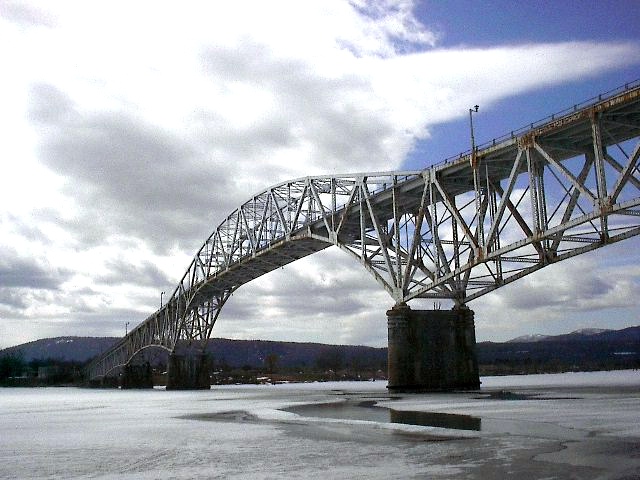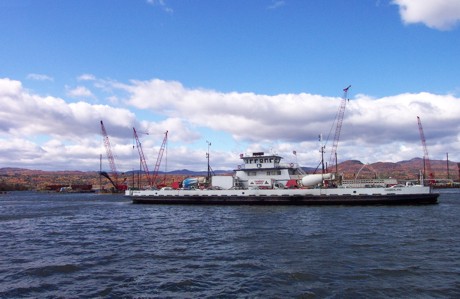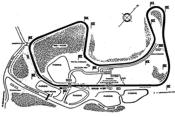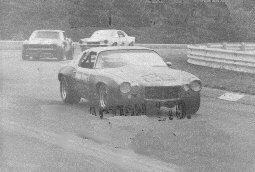Some Internet sites were down yesterday. January 18 was “the Day the Web Went on Strike.”
[Visit Wikipedia:SOPA initiative to learn more]
“What? You were gone?”
The widespread, grassroots action protested Congress’ plans for the onerous Stop Online Piracy Act (SOPA). Those bills will establish a system to take down any website the Justice Department decides infringes on someone’s copyright. SOPA will allow the DoJ to demand that all search engines, all social networking sites, and all domain name services block access to any site they target. It would also make unauthorized web streaming of copyrighted content a felony with a penalty of up to five years in prison.
Yesterday’s showdown occurred because SOPA completely eliminates due process from those site takedown orders all in the name of stopping “offshore piracy websites” from ruining our movie and record industry.
“This may pinch a little.”
Wikipedia founder Jimmy Wales called yesterday’s extraordinary strike a necessary action because, “We simply cannot ignore the fact that SOPA and PIPA endanger free speech both in the United States and abroad, and set a frightening precedent of Internet censorship for the world.”
Some sites seized under earlier rules have been down for more a year with neither explanation nor recourse.
Imagine if federal agents had raided the St. Albans Messenger building in St. Albans on Thanksgiving Day of 2010, seized Publisher Emerson Lynn’s printing presses, printed a special edition with a banner headline that New England’s oldest afternoon daily newspaper was a vast criminal enterprise, and locked the doors. Now imagine that every Messenger employee was out of work for a year. That you could not read my column every Thursday. That the seizure was done under seal so Mr. Lynn never even knew what the charges were.
Now imagine that federal agents abruptly took the locks off the doors a year later, on Thanksgiving Day, 2011. “Oops. Never mind,” they said.
Couldn’t happen? ICE abruptly seized the dajaz1.com website under seal in a widespread Thanksgiving weekend action in 2010. They returned that site with no explanation a year later. Site owner and hip-hop fan “Splash” of Queens, NY, lost his livelihood for a year. They hadn’t yet even dreamed of SOPA by then.
And you thought Oops was a word only political candidates used.
Major sites that went black in yesterday’s strike included the English version of Wikipedia, plus reddit, Boing Boing, and AllArts.org. Major sites that remained active included all .GOV resources.
Wikipedia blacked out its results for 24 hours. Other organizations opposing SOPA include the American Civil Liberties Union, American Library Association, Bloomberg, Brookings Institution, the Computer & Communications Industry Association, Consumers Union, Creative Commons, Electronic Frontier Foundation, Facebook, Go Daddy, Google, Human Rights Watch, Twitter, Writers Guild of America, Yahoo, and Zynga.
“There are effective ways to combat foreign ‘rogue’ websites dedicated to copyright infringement and trademark counterfeiting,” Google notes. Instead, the US Congress chooses to go with TSA-style bullying. Good to see that the tried-and-true Joe McCarthy approach never goes out of style inside the Beltway.
Copyright infringement hurts everyone. Although musicians with major label contracts receive only pennies in sales from music sales, Vermont artists such as Carol Ann Jones, Will Patton, and Nobby Reed who produce their own albums lose real money with every song you rip from youtube.
No one on the list thinks theft is a good idea, whether it is a kid stuffing a CD down his pants at the Flying Disc in Enosburg or an organized ring selling pirated copies of a bestseller. Everyone on the list thinks government actions like SOPA are a fate worse than theft.
I could get behind the Stop Our Politicians Act but the way this turkey is written, it’s NO SOAP.
Resources for Further Reading
|
UPDATE JANUARY 19, 2012
The news reports that the bills are dead for now. Harry Reid won’t bring PIPA to a vote in the Senate and Congress Critters are running for cover despite Christopher Dodd (the “Rubble” half of Barny Rubble)’s presence on all the newscasts.
It’s not over, though.
SOPA is gonna come back as APOS.
UPDATE JANUARY 21, 2012
And it has. Only the initials have changed.
The Anti-Counterfeiting Trade Agreement, or ACTA, is called a “plurilateral” trade agreement under negotiation by the US, Canada, Japan, European Union, South Korea, Mexico, Switzerland, Australia and New Zealand. It is the backdoor to SOPA except it is a world governance act and it is one that Mr. Obama has said he would approve by executive order.
Whitehouse.gov has a petition to send ACTA to the Senate for ratification instead plus an end ACTA altogether petition. You must register with the .GOV to sign either petition. The second had 40,999 signatures when I signed it (I was number 41,000). The first, a backstop if the Administration ignores us for the second, still needs a lot of signatures.

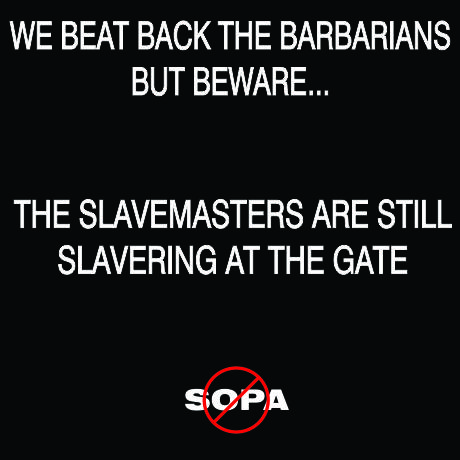
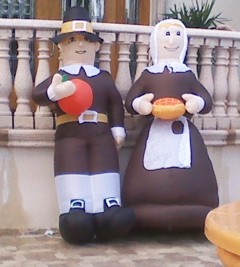 I’ll come back to the sandwiches.
I’ll come back to the sandwiches.
